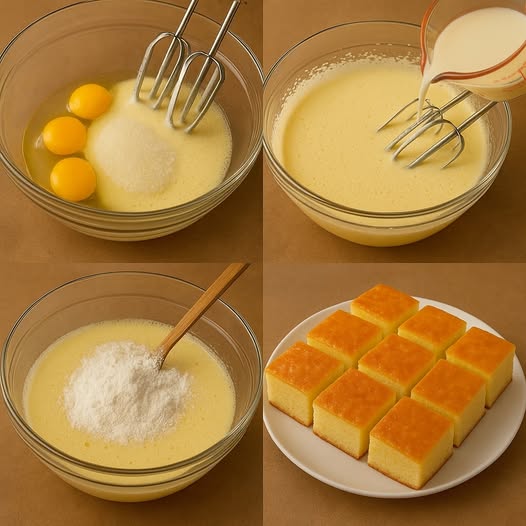Soft, Bouncy, and Gently Sweet Japanese Sponge Cake
Prep Time: 20 minutes
Cook Time: 45–50 minutes
Cooling Time: 1 hour
Total Time: ~2 hours
Servings: 8–10 slices
Difficulty: Intermediate
What Is Castella Cake?
Castella Cake, or Kasutera (カステラ), is a famous Japanese sponge cake with Portuguese origins, dating back to the 16th century. It’s made with just a handful of ingredients—eggs, sugar, bread flour, and honey—yet produces a tall, glossy, golden-brown loaf with a fluffy, custardy crumb and a hint of chew.
Perfect for teatime, holidays, or when you’re craving something elegant yet simple.
Ingredients
| Ingredient | Quantity | Notes |
|---|---|---|
| Large eggs | 4 | Room temperature, very fresh |
| Granulated sugar | 120g (½ cup + 2 tbsp) | Superfine if possible, for smoother texture |
| Bread flour | 100g (¾ cup + 1 tbsp) | High-protein flour creates the signature chew |
| Honey | 2 tablespoons | Mixed with warm water for easy incorporation |
| Warm water | 1 tablespoon | To dissolve honey |
| Milk (optional) | 1 tablespoon | Adds softness, use if batter feels too thick |
Bread flour is key for the classic Castella “bounce” and fine crumb. Cake flour results in a softer but less authentic texture.
Equipment Needed
-
8×4-inch loaf pan (or 7-inch square pan)
-
Parchment paper
-
Hand mixer or stand mixer
-
Large mixing bowl
-
Fine mesh sieve
-
Kitchen scale (recommended for precision)
Instructions
Step 1: Preheat and Prep the Pan
-
Preheat oven to 160°C (320°F).
-
Line your pan with parchment paper, allowing extra over the sides.
-
Wrap the outside of the pan with a wet towel strip or place inside a water bath to ensure gentle, even baking.
Step 2: Warm the Eggs and Sugar
-
In a large bowl, beat eggs + sugar together.
-
Place bowl over a warm water bath (not boiling) and whisk gently until sugar begins to dissolve and mixture feels warm (around 40–45°C or 104–113°F).
-
Remove from heat.
Step 3: Beat to Ribbon Stage
-
Using a mixer, beat the eggs and sugar on high speed for 5–7 minutes until:
-
Pale and tripled in volume
-
Thick enough to form ribbons when dripped
-
Ribbon Test: Lift the whisk—batter should fall like a ribbon and sit on top for a few seconds before disappearing.
Step 4: Add Flour
-
Sift bread flour into the egg mixture in 2–3 batches.
-
Gently fold with a spatula using wide, circular motions to avoid deflating the air.
Step 5: Add Honey Mixture
-
Mix honey and warm water (plus milk if using) until smooth.
-
Add into batter and fold until just incorporated.
Do not overmix—deflation = dense cake.
Step 6: Pour and Tap
-
Pour the batter into the prepared pan from a height (to pop air bubbles).
-
Tap the pan 2–3 times on the counter to remove large bubbles.
-
Use a skewer or chopstick to swirl through the batter and release hidden bubbles.
Step 7: Bake Low and Slow
-
Bake at 160°C (320°F) for 45–50 minutes, or until:
-
Top is golden brown
-
A skewer inserted comes out clean
-
Optional: Bake inside a larger pan filled with 1 inch of hot water for a moister texture.
Step 8: Cool and Rest
-
Once baked, immediately remove the cake from the pan using the parchment sling.
-
Peel off paper and wrap warm cake in plastic wrap or place in a sealed container.
-
Rest overnight at room temp or chill for a finer texture and more flavor depth.
Serving Suggestions
-
Slice with a serrated knife for clean edges.
-
Enjoy as-is with green tea, coffee, or milk.
-
Serve with a side of whipped cream, berries, or a honey drizzle.
Storage Tips
-
Room Temp: Wrapped, for up to 3 days
-
Fridge: In airtight container, up to 5–6 days
-
Freezer: Slices can be frozen up to 1 month (wrap tightly in plastic + foil)
❓ FAQs
Q: Why use bread flour instead of cake flour?
A: Bread flour gives Castella its chewy bite and structure. It’s essential for the authentic Japanese texture.
Q: Can I use a round cake pan?
Yes, but you’ll need to adjust the baking time. A square or loaf pan is traditional and helps form the tall, uniform shape.
Q: Why rest overnight?
Resting softens the crumb and enhances flavor. It’s a traditional step in Castella baking for best results.
Q: My cake shrunk after baking—what happened?
Common causes: overmixing, sudden temperature changes, or underbaking. Be gentle during folding and bake thoroughly.
✨ Final Thoughts
This Castella Cake is all about balance: simple ingredients, refined technique, and a pillowy finish that speaks of care and patience. Whether you’re a seasoned baker or a curious home cook, mastering this Japanese favorite will reward you with a slice of cloudlike perfection.
Save or Pin This Recipe
Make it once—and you’ll dream about it often.
#CastellaCake #Kasutera #JapaneseBaking #SpongeCake #TeaTimeTreat #HoneyCake #MinimalistDessert

